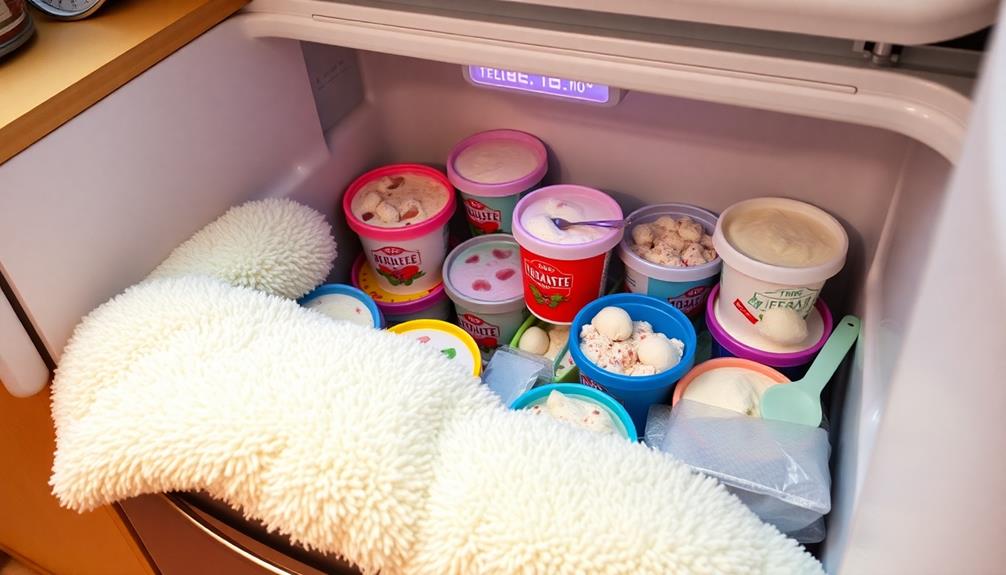To make your ice cream last longer in the freezer, store it in airtight containers to prevent freezer burn. Keep the ice cream at the back of the freezer, away from warm air, and maintain a consistent temperature below 0°F (-18°C). Use shallow, flat containers to promote faster freezing and minimize ice crystals. Consider adding a layer of plastic wrap over the surface before sealing. Limit how long you leave the container open to avoid melting and refreezing. With these tips, you'll preserve your ice cream's flavor and texture for longer. There's more to discover that can help refine your methods. Mastering the art of ice cream scooping is also important for preserving the quality of your ice cream. Using a warm ice cream scoop or running it under hot water can help you get the perfect scoop without damaging the ice cream. Additionally, storing your ice cream in the coldest part of the freezer and avoiding frequent temperature fluctuations will contribute to the overall quality of your frozen treat. By paying attention to these details, you can enjoy your favorite flavors for weeks or even months without compromising on taste or texture.
Key Takeaways
- Store ice cream in shallow, flat plastic containers to promote faster freezing and reduce ice crystal formation.
- Ensure containers are airtight with tight-fitting lids to prevent air exposure and freezer burn.
- Keep the freezer temperature consistently below 0°F (-18°C) for optimal ice cream quality.
- Limit serving time to prevent melting and refreezing, which can create ice crystals.
- Consume homemade ice cream within one to two weeks to avoid freezer burn and maintain freshness.
Understanding Freezer Burn
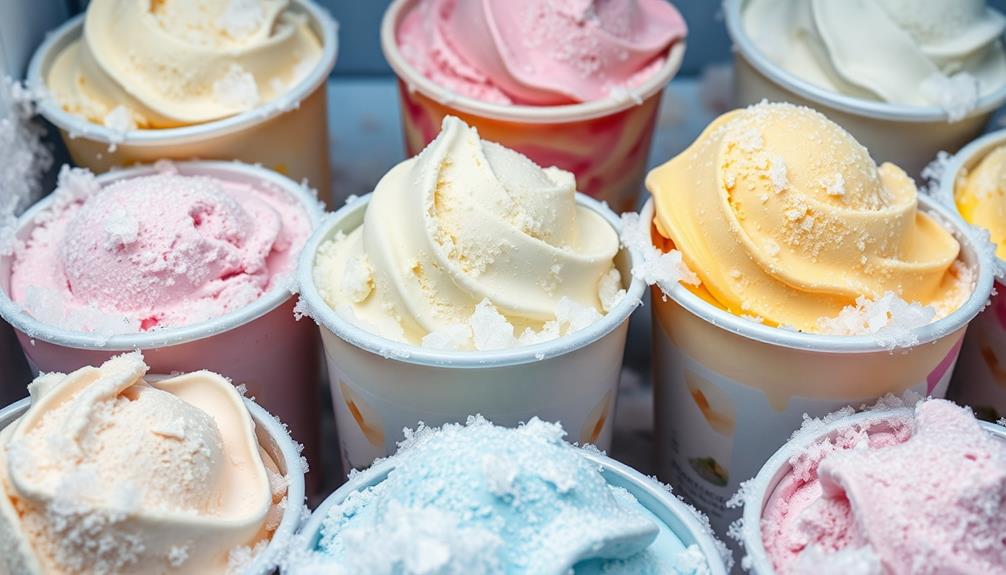
Freezer burn can be a frustrating experience for ice cream lovers. It happens when moisture evaporates from the surface of your ice cream, leading to dehydration and the formation of ice crystals. You might notice signs like discoloration, texture changes, or those pesky ice crystals on your favorite treat.
Not only does freezer burn diminish the visual appeal of your ice cream, but it also ruins that creamy taste you crave.
To prevent freezer burn, you need to minimize your ice cream's exposure to air during storage. Using airtight containers is essential for maintaining quality. If you don't have these handy, think about wrapping the ice cream tightly with plastic wrap before sealing it in a container. This extra layer of protection can go a long way in preserving your dessert.
Another factor to reflect on is the temperature in your freezer. Temperature fluctuations can exacerbate freezer burn, so it's vital to keep your freezer at a consistent low temperature.
Keeping Ice Cream Cold
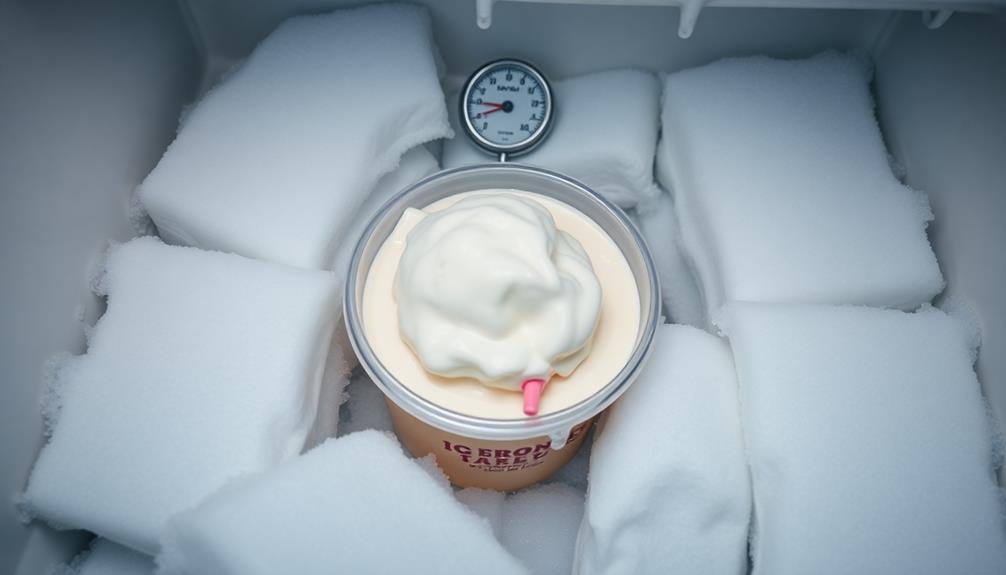
To enjoy your ice cream at its best, keeping it cold is essential. Maintaining a consistent freezer temperature below 0°F (-18°C) guarantees your ice cream remains creamy and free from that unwanted icy texture.
Here are some tips to help you keep your ice cream cold:
- Position containers at the back: Store your ice cream containers near the back of the freezer, away from the door. This minimizes exposure to warm air every time the door opens.
- Limit serving time: When serving, keep ice cream out of the freezer for as little time as possible. Even a brief period can lead to melting and refreezing, which creates ice crystals.
- Use a freezer thermometer: Regularly check the temperature of your freezer with a thermometer. This helps you maintain ideal freezing conditions and adjust settings if needed.
- Seal the freezer door: Always keep the freezer door tightly closed to maintain an even temperature and protect your ice cream from warm air.
Best Container for Storage
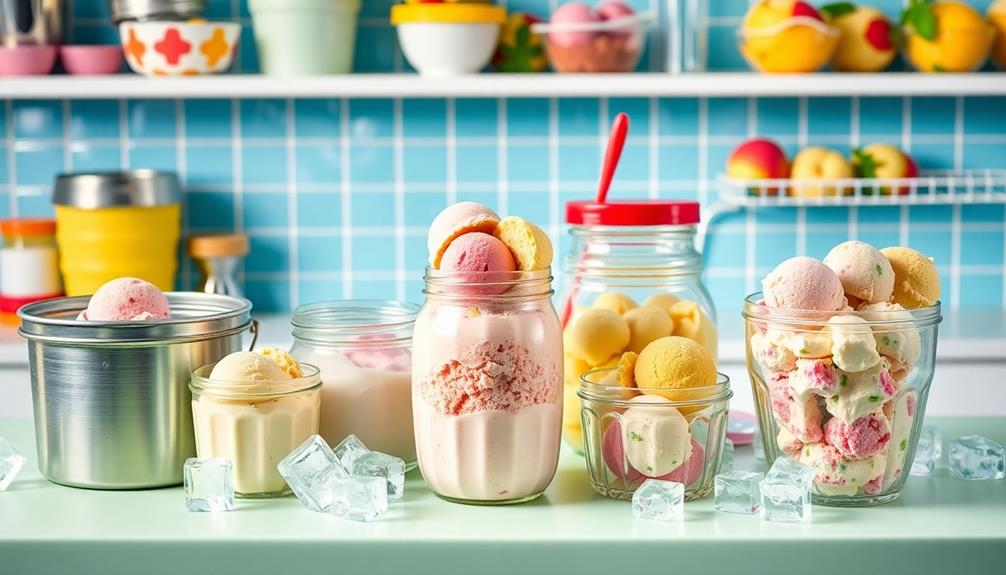
When it comes to storing ice cream, the right container can make all the difference in keeping it fresh and creamy. The best container for storage is a shallow, flat plastic container. This design promotes faster freezing and reduces the risk of forming large ice crystals, ensuring your ice cream stays smooth.
Plastic containers are preferable to glass or ceramics, as they're more durable and provide better heat conductivity, which helps maintain the right temperature.
Look for a container with a tight-fitting lid. This feature is essential for preventing air exposure, which can lead to freezer burn and diminish flavor over time.
Using smaller containers is also a smart move; they minimize trapped air and allow for quicker freezing, making it easier for you to scoop out individual portions without hassle.
Additionally, consider a container with enough headroom to accommodate any ice cream expansion during freezing. This prevents spills and keeps your freezer clean.
Importance of Airtight Sealing
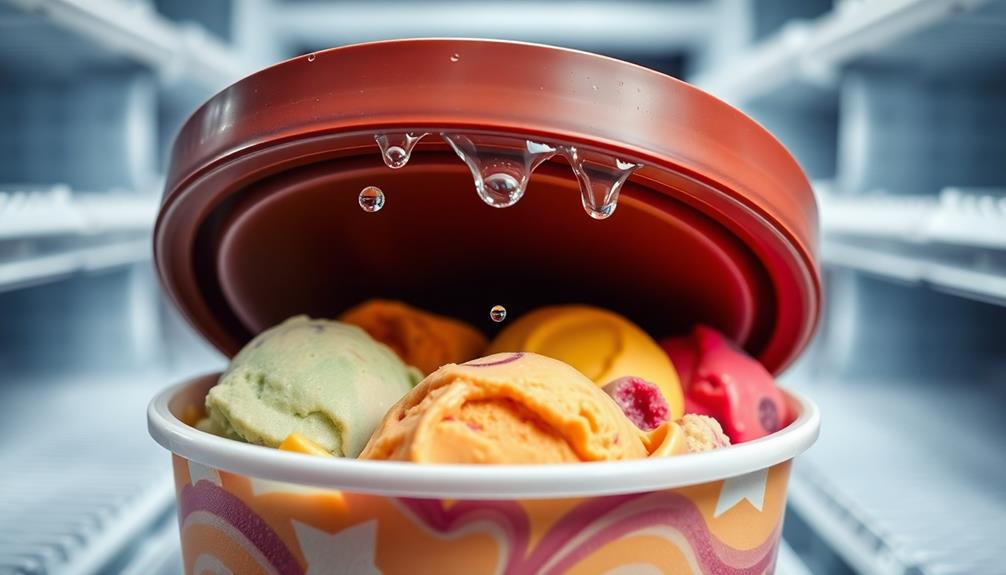
Airtight sealing is essential for keeping your ice cream in top shape.
It prevents freezer burn and odor absorption, which can ruin the taste and texture of your favorite treat.
Preventing Freezer Burn
Keeping your ice cream fresh hinges on preventing freezer burn, which occurs when it's exposed to air. This leads to moisture loss and ice crystal formation, ruining the texture and flavor.
To keep your ice cream at its finest, follow these steps:
- Use Airtight Containers: Always store your ice cream in airtight containers with tight-fitting lids. This minimizes air exposure, preserving quality.
- Add Plastic Wrap: Before sealing the container, lay a layer of plastic wrap directly on the surface of the ice cream. This extra barrier helps further block air ingress.
- Opt for Smaller Containers: Using smaller containers can reduce trapped air. They freeze quicker and are less affected by temperature fluctuations.
- Consume Quickly: For peak taste and texture, aim to enjoy homemade ice cream within one to two weeks. The longer it sits, the higher the risk of freezer burn.
Odor Absorption Reduction
Preventing freezer burn is just one part of ensuring your ice cream stays delicious. Another essential aspect is reducing odor absorption. Ice cream contains fat, which can easily absorb unwanted smells from the surrounding air in your freezer. To combat this, always store your ice cream in airtight containers. This helps maintain its flavor integrity and prevents it from picking up any off-putting odors.
Additionally, consider using a layer of plastic wrap pressed directly onto the surface of the ice cream before sealing the container. This extra barrier minimizes air exposure, further reducing the risk of odor absorption and freezer burn. Remember, minimizing air pockets in the container is fundamental for preserving both flavor and texture.
If you've got leftover ice cream, using smaller, airtight containers can be a game-changer. They limit air exposure, which helps keep your ice cream tasting fresh for a longer time.
For the best results, try to consume homemade ice cream within one to two weeks. The longer it's stored, the higher the chance of flavor degradation due to odor absorption.
Keep these tips in mind, and enjoy your ice cream at its best!
Maintaining Texture Quality
The key to enjoying smooth, creamy ice cream lies in how you store it.
Using airtight containers is crucial for maintaining texture quality and preventing freezer burn. When ice cream is exposed to air, the fat can absorb odors, compromising both flavor and texture.
Here's how to keep your ice cream at its best:
- Use small airtight containers: They minimize trapped air, reducing the formation of ice crystals.
- Press plastic wrap onto the surface: This extra layer creates a barrier against air exposure, further preventing freezer burn.
- Check regularly for ice crystals: If you spot significant crystallization, re-churning can help restore a smoother texture.
- Consume homemade ice cream within one to two weeks: This timeframe guarantees you enjoy peak flavor and texture before degradation sets in.
Freezing Techniques for Quality
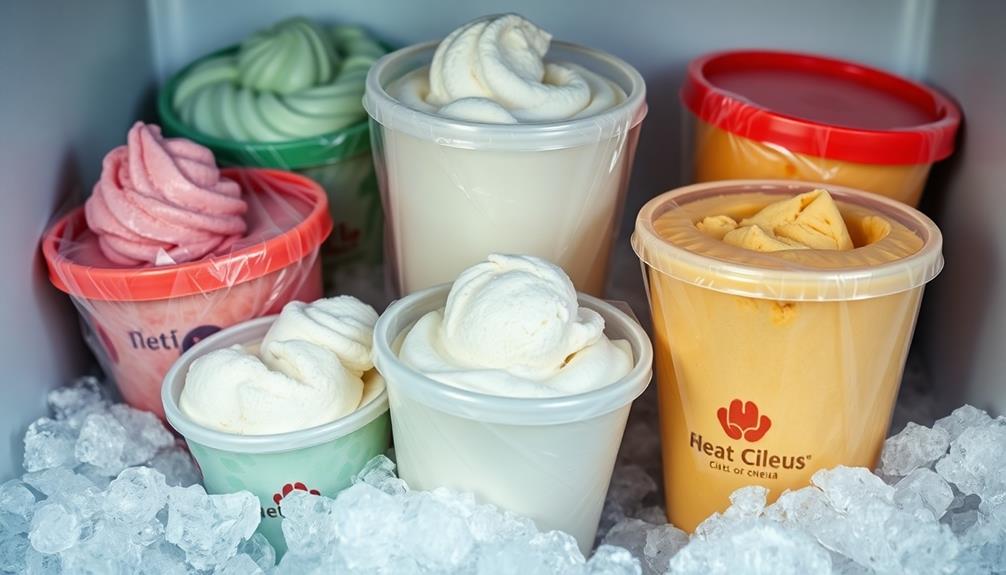
To keep your ice cream at its best, mastering freezing techniques is key.
You'll want to focus on rapid freezing methods, choose the right containers, and use proper sealing techniques.
Rapid Freezing Methods
Rapid freezing methods are key to achieving the best texture and longevity for your ice cream. By minimizing ice crystal formation, you guarantee a smoother, creamier dessert that lasts longer in your freezer.
Here are some effective techniques to enhance your rapid freezing process:
- Use Shallow Containers: Opt for shallow containers to increase surface area, which leads to quicker freezing times and improved quality.
- Pre-Chill Everything: Before mixing, pre-chill your ingredients, bowls, and utensils. This helps lower the initial temperature, promoting faster freezing once you place your mixture in the freezer.
- Blast Freezer Advantage: If you have access to a blast freezer, use it! This method drastically reduces freezing time while maintaining that desirable creamy texture, far superior to traditional home freezers.
- Optimal Storage Location: Avoid the freezer door, as it experiences more temperature fluctuations. Instead, place your ice cream in the back, where temperatures are more stable.
Container Selection Tips
Choosing the right container for your ice cream is essential for maintaining its quality and extending its shelf life. Start with shallow, wide containers; they promote faster freezing and help reduce temperature fluctuations.
Plastic containers are your best bet over glass or ceramic, as plastic has better heat conductivity, ensuring consistent temperatures.
Make sure your containers are freezer-proof and allow for headroom to accommodate ice cream expansion. This will prevent spills and maintain the integrity of your dessert.
For added protection, press cling film directly onto the surface of the ice cream before sealing with a lid. This minimizes air exposure, which can lead to flavor absorption and freezer burn.
When it comes to shape, opt for square or rectangular containers. These aren't only ergonomic but also stack easily in the freezer, maximizing your storage space.
Following these container selection tips will help you keep your ice cream fresh and delicious for longer. By investing a little thought into your storage solutions, you'll enjoy your homemade treats at their best!
Proper Sealing Techniques
Proper sealing techniques are essential for keeping your ice cream fresh and preventing freezer burn. By minimizing air exposure, you can maintain the creamy texture and delightful flavor of your favorite treat.
Here are some effective methods to seal your ice cream:
- Use airtight containers: Opt for containers with tight-fitting lids to limit air contact, which helps prevent freezer burn.
- Add plastic wrap: Before sealing the lid, press a layer of plastic wrap directly onto the surface of the ice cream. This extra barrier minimizes moisture and air exposure.
- Choose shallow, wide containers: These containers promote faster freezing, reducing ice crystal formation and guaranteeing a smoother texture.
- Leave headroom for expansion: Confirm your container has enough space for ice cream to expand as it freezes; this prevents cracking and further air exposure.
Remember to regularly check the plastic wrap after serving and re-press it to cover any exposed areas.
Factors Influencing Texture
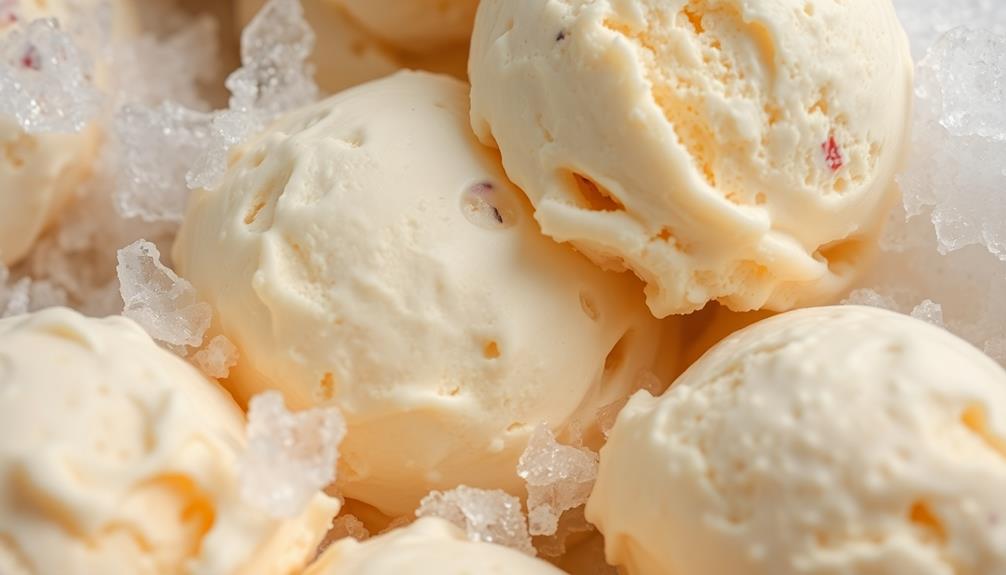
Frequently, the texture of ice cream is influenced by several key factors that can enhance or detract from your indulgence. One of the most significant elements is fat content; for ideal creaminess and smoothness, aim for around 17% fat. Incorporating egg yolks can also elevate the texture due to their emulsifying properties, providing a richer mouthfeel.
Stabilizers like guar gum or xanthan gum play an essential role as well. They help reduce ice crystal formation, ensuring your ice cream maintains a creamy consistency.
Additionally, the incorporation of air during churning, known as overrun, is vital. Aim for about 50% overrun to achieve that light and fluffy texture, preventing your ice cream from becoming overly dense.
Lastly, consider the freezing point of water. Using a higher ratio of liquid sweeteners, like corn syrup, instead of granulated sugar can effectively lower this freezing point, resulting in a softer and smoother texture.
Impact of Ingredients
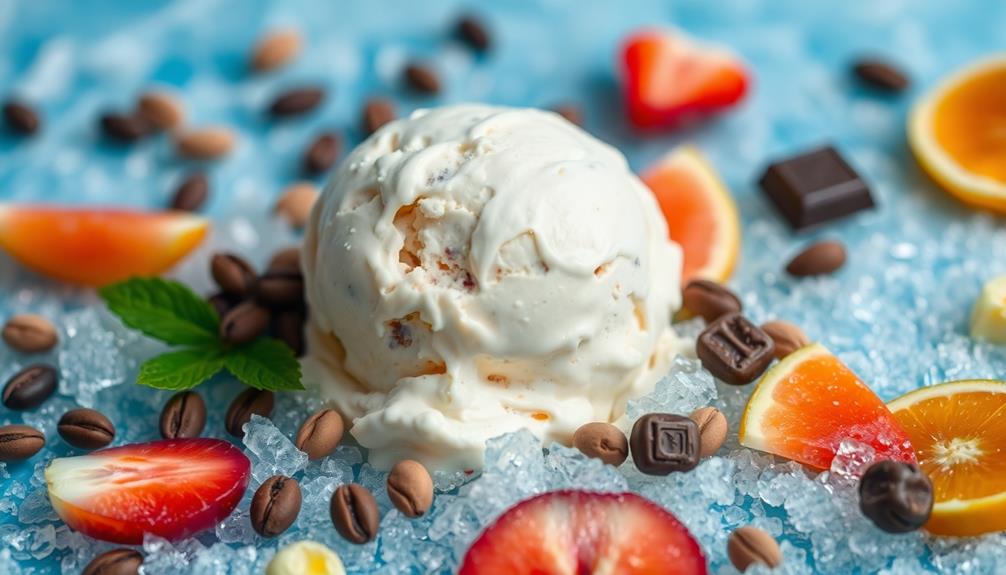
The impact of ingredients plays an essential role in determining the quality and longevity of your homemade ice cream. By choosing the right components, you can greatly improve its texture and shelf life.
Here are four key ingredients to take into account:
- Stabilizers: Adding stabilizers like guar gum or xanthan gum helps prevent ice crystal formation, ensuring a smoother texture and extending freshness.
- Fat Content: Aim for a fat content of around 17%. Higher fat levels contribute to creaminess and minimize ice crystal formation during storage.
- Corn Syrup: Using liquid sweeteners like corn syrup instead of granulated sugar lowers the freezing point, resulting in softer ice cream that stays enjoyable longer without hardening.
- Alcohol: Incorporating alcohol, such as vodka or flavored liquors, enhances softness and helps prevent ice from forming, allowing your ice cream to maintain its delightful texture over time.
Tips for Homemade Ice Cream
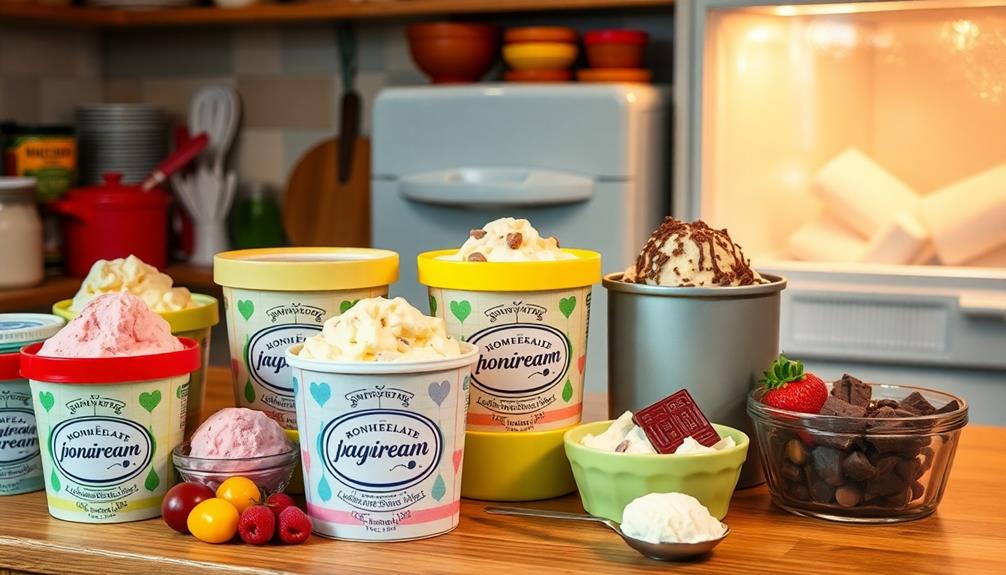
Creating your own ice cream can be a delightful experience, but to make it last longer and taste better, you need some handy tips.
First, always use airtight containers to store your ice cream. Opt for flat, wide containers with a high surface-area-to-volume ratio to minimize air exposure and prevent freezer burn.
Consider adding stabilizers like guar gum or xanthan gum to your recipe; these help enhance texture and reduce ice crystal formation during storage.
After churning, allow your homemade ice cream to ripen in the refrigerator for a few hours. This step improves flavor and texture before you freeze it completely.
When it's time to store your ice cream, keep it in the coldest part of the freezer, usually at the back. Avoid frequently opening the freezer door to maintain a consistent low temperature below 0°F (-18°C).
For the best taste and quality, consume your homemade ice cream within one to two weeks. Prolonged storage can lead to a noticeable decline in flavor and texture, so enjoy it while it's fresh!
Frequently Asked Questions
How to Keep Ice Cream Longer in the Freezer?
To keep ice cream longer in the freezer, store it in airtight containers, place it at the back where it's coldest, and monitor the temperature. Avoid frequent openings to maintain consistent conditions and prevent melting.
How Do You Make Homemade Ice Cream Stay Frozen Longer?
Think of your homemade ice cream as a treasure. To keep it frozen longer, store it in airtight containers, maintain a consistent freezer temperature, and avoid the door to shield it from temperature swings. Enjoy promptly!
How to Prevent Ice Cream From Melting Quickly?
To prevent ice cream from melting quickly, store it in the back of the freezer, use airtight containers, minimize time out at room temperature, and avoid placing it in the door for consistent cold.
How Do You Increase the Shelf Life of Ice Cream?
To increase ice cream's impressive lifespan, keep it consistently cold, contain it carefully in airtight containers, and coat with plastic wrap. Avoid thawing too often, as that can compromise its creamy consistency and delightful flavor.
Conclusion
By following these simple tips, you can keep your ice cream fresh and delicious for longer. After all, who wants to savor a bowl of freezer-burned disappointment? With the right container, airtight sealing, and proper freezing techniques, you'll enjoy that creamy delight just as it was meant to be. So, next time you indulge in a scoop, remember: a little care goes a long way in preserving your sweet treat's flavor and texture.
